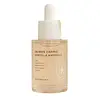What's inside
What's inside
 Key Ingredients
Key Ingredients

 Benefits
Benefits

 Concerns
Concerns

No concerns
 Ingredients Side-by-side
Ingredients Side-by-side

Water
Skin ConditioningTripropylene Glycol
AntioxidantButylene Glycol
HumectantGlycerin
HumectantDipropylene Glycol
HumectantRosa Damascena Flower Water
MaskingNiacinamide
Smoothing1,2-Hexanediol
Skin ConditioningGlyceryl Glucoside
HumectantHydroxyacetophenone
AntioxidantGellan Gum
Magnesium Sulfate
Polyglyceryl-10 Laurate
Skin ConditioningXanthan Gum
EmulsifyingEthylhexylglycerin
Skin ConditioningAdenosine
Skin ConditioningSodium Phytate
Psoralea Corylifolia Fruit Extract
Skin ConditioningRosa Damascena Callus Culture Extract
AntioxidantOlea Europaea Fruit Oil
MaskingCedrus Deodara Wood Oil
MaskingBakuchiol
AntimicrobialChamaecyparis Obtusa Oil
MaskingLavandula Angustifolia Oil
MaskingCyanocobalamin
Skin ConditioningSodium Dna
Skin ConditioningEpilobium Angustifolium Flower/Leaf/Stem Extract
Skin ConditioningLactobacillus Ferment Lysate
Skin ConditioningNicotinamide Mononucleotide
AntioxidantAmyris Balsamifera Bark Oil
MaskingVitis Vinifera Leaf Oil
MaskingCeramide NP
Skin ConditioningWater, Tripropylene Glycol, Butylene Glycol, Glycerin, Dipropylene Glycol, Rosa Damascena Flower Water, Niacinamide, 1,2-Hexanediol, Glyceryl Glucoside, Hydroxyacetophenone, Gellan Gum, Magnesium Sulfate, Polyglyceryl-10 Laurate, Xanthan Gum, Ethylhexylglycerin, Adenosine, Sodium Phytate, Psoralea Corylifolia Fruit Extract, Rosa Damascena Callus Culture Extract, Olea Europaea Fruit Oil, Cedrus Deodara Wood Oil, Bakuchiol, Chamaecyparis Obtusa Oil, Lavandula Angustifolia Oil, Cyanocobalamin, Sodium Dna, Epilobium Angustifolium Flower/Leaf/Stem Extract, Lactobacillus Ferment Lysate, Nicotinamide Mononucleotide, Amyris Balsamifera Bark Oil, Vitis Vinifera Leaf Oil, Ceramide NP
Centella Asiatica Leaf Water
Skin ConditioningButylene Glycol
HumectantWater
Skin ConditioningPropanediol
Solvent1,2-Hexanediol
Skin ConditioningGlycerin
HumectantSodium Dna
Skin ConditioningSalmon Egg Extract
Madecassoside
AntioxidantPortulaca Oleracea Water
Skin ConditioningPersea Gratissima Fruit Extract
EmollientMaltodextrin
AbsorbentHyaluronic Acid
HumectantHydrolyzed Hyaluronic Acid
HumectantTheobroma Cacao Extract
Skin ConditioningChenopodium Quinoa Seed Extract
Skin ConditioningHydrolyzed Wheat Protein
Skin ConditioningBetaine
HumectantDextrin
AbsorbentSodium Hyaluronate
HumectantCarbomer
Emulsion StabilisingEthylhexylglycerin
Skin ConditioningAmmonium Acryloyldimethyltaurate/Vp Copolymer
Tromethamine
BufferingDisodium EDTA
Centella Asiatica Leaf Water, Butylene Glycol, Water, Propanediol, 1,2-Hexanediol, Glycerin, Sodium Dna, Salmon Egg Extract, Madecassoside, Portulaca Oleracea Water, Persea Gratissima Fruit Extract, Maltodextrin, Hyaluronic Acid, Hydrolyzed Hyaluronic Acid, Theobroma Cacao Extract, Chenopodium Quinoa Seed Extract, Hydrolyzed Wheat Protein, Betaine, Dextrin, Sodium Hyaluronate, Carbomer, Ethylhexylglycerin, Ammonium Acryloyldimethyltaurate/Vp Copolymer, Tromethamine, Disodium EDTA
 Reviews
Reviews

Ingredients Explained
These ingredients are found in both products.
Ingredients higher up in an ingredient list are typically present in a larger amount.
1,2-Hexanediol is a synthetic liquid and another multi-functional powerhouse.
It is a:
- Humectant, drawing moisture into the skin
- Emollient, helping to soften skin
- Solvent, dispersing and stabilizing formulas
- Preservative booster, enhancing the antimicrobial activity of other preservatives
Butylene Glycol (or BG) is used within cosmetic products for a few different reasons:
Overall, Butylene Glycol is a safe and well-rounded ingredient that works well with other ingredients.
Though this ingredient works well with most skin types, some people with sensitive skin may experience a reaction such as allergic rashes, closed comedones, or itchiness.
Learn more about Butylene GlycolEthylhexylglycerin (we can't pronounce this either) is commonly used as a preservative and skin softener. It is derived from glyceryl.
You might see Ethylhexylglycerin often paired with other preservatives such as phenoxyethanol. Ethylhexylglycerin has been found to increase the effectiveness of these other preservatives.
Glycerin is already naturally found in your skin. It helps moisturize and protect your skin.
A study from 2016 found glycerin to be more effective as a humectant than AHAs and hyaluronic acid.
As a humectant, it helps the skin stay hydrated by pulling moisture to your skin. The low molecular weight of glycerin allows it to pull moisture into the deeper layers of your skin.
Hydrated skin improves your skin barrier; Your skin barrier helps protect against irritants and bacteria.
Glycerin has also been found to have antimicrobial and antiviral properties. Due to these properties, glycerin is often used in wound and burn treatments.
In cosmetics, glycerin is usually derived from plants such as soybean or palm. However, it can also be sourced from animals, such as tallow or animal fat.
This ingredient is organic, colorless, odorless, and non-toxic.
Glycerin is the name for this ingredient in American English. British English uses Glycerol/Glycerine.
Learn more about GlycerinSodium DNA is an emerging anti-aging ingredient.
It is created by taking deoxyribonucleic acid (DNA) and purifying it with sodium hydroxide.
The DNA is extracted from several different animal sources, including: calf thymus, the gonadic tissue of a male sturgeon, or herring / salmon sperm.
You have probably seen this ingredient in anti-aging skincare. But what is it?
DNA is composed of nucleotides, or chemical building blocks. Nucleotides include adenine (A), thymine (T), guanine (G), and cytosine (C). Talk about a flashback to biology! Nucleosides are formed from these nucleotides.
The science behind Sodium DNA is based on an ingredient called Polydeoxyribonucleotide or PDRN.
PDRN are DNA fragments mainly extracted from the sperm cells of trout or salmon. Meaning, PDRN can be derived from Sodium DNA.
PDRN consists of chains of nucleotides and nucleosides mentioned above. They can range anywhere from 80 - 2000 pairs.
Studies show PDRN has the following properties:
Most of the research on PDRN has been done using injectable forms. That’s important, because PDRN is a large molecule and doesn’t absorb well through the skin. So if you’re applying it topically, the effects are likely to be much milder.
Still, topical Sodium DNA is emerging as a trendy anti-aging ingredient. It’s generally well-tolerated and offers good biocompatibility with human skin, making it a low-risk addition to most routines.
Further studies are needed to truly confirm this ingredients anti-aging ability (Remember, retinol has decades of research!).
When using this ingredient, is is best to ask a brand about the source of their Sodium DNA. You'll want to find products where the Sodium DNA is sourced from fish. Some Sodium DNA is derived from calf / cow thymus.
Needless to say, this ingredient is not vegan.
Learn more about Sodium DnaWater. It's the most common cosmetic ingredient of all. You'll usually see it at the top of ingredient lists, meaning that it makes up the largest part of the product.
So why is it so popular? Water most often acts as a solvent - this means that it helps dissolve other ingredients into the formulation.
You'll also recognize water as that liquid we all need to stay alive. If you see this, drink a glass of water. Stay hydrated!
Learn more about Water